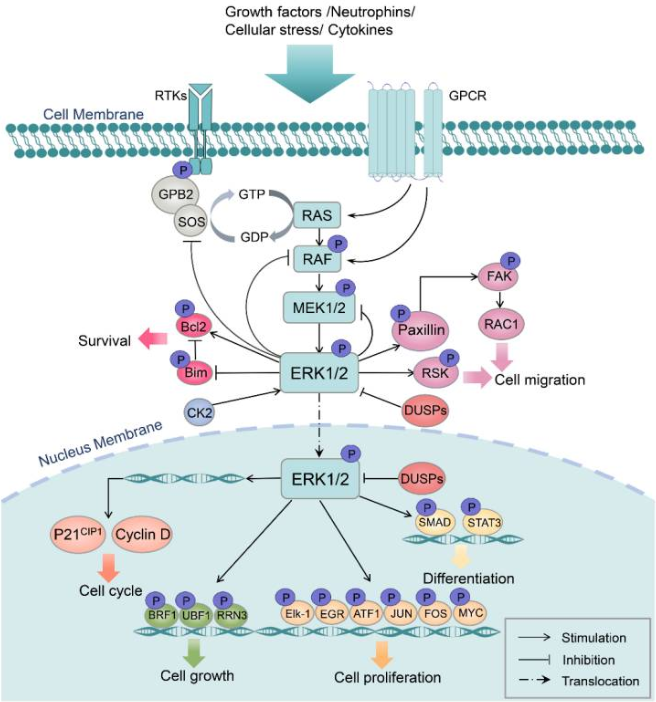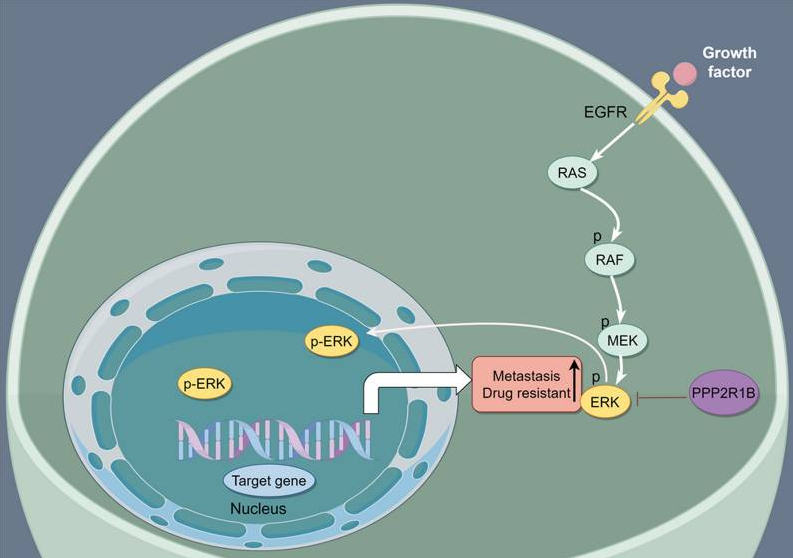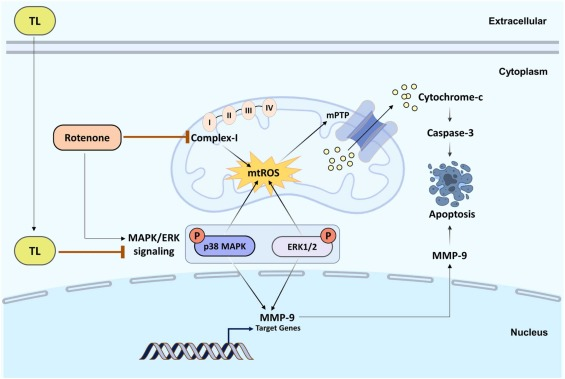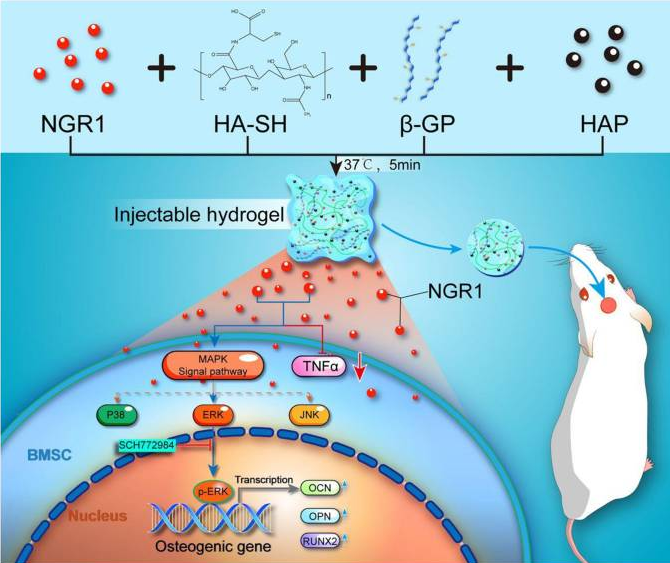The MAPK/ERK signaling pathway: A core hub from basic biology to human diseases
The MAPK/ERK signaling pathway: A core hub from basic biology to human diseases
1. Introduction of the MAPK Pathway
The mitogen-activated protein kinase (MAPK) cascade is a key signaling pathway regulating various cellular processes, including proliferation, differentiation, apoptosis and stress response. The MAPK pathway functions through signal cascades, transmitting extracellular signals to intracellular targets, enabling cells to respond to various specific extracellular stimuli. The MAPK pathway includes three major kinases, namely MAPK kinase-kinase (MAP3K), MAPK kinase (MAPKK), and MAPK, which activate and phosphorylate downstream proteins. Current research has identified four major and distinct MAPK cascade reactions: extracellular signal-regulated kinases 1 and 2 (ERK1/2), c-Jun N-terminal kinases (1, 2, and 3), p38 MAPK (α, β, γ, and δ), and ERK5. This article focuses on the MAPK/ERK signaling pathway.
1.1. The function of MAPK/ERK pathway
The MAPK/ERK pathway is a crucial cellular signaling pathway. Its core function is to amplify and transmit extracellular growth factor signals (such as proliferation-promoting and differentiation-inducing instructions) step by step into the cell nucleus. By activating specific transcription factors, it regulates gene expression and thereby dominates multiple key biological processes of cells, including proliferation, differentiation, survival, and metabolism. Excessive activation of upstream proteins and kinases in the ERK pathway has been proven to induce various diseases, including cancer, inflammation, developmental disorders and neurological diseases. Furthermore, the MAPK/ERK pathway plays a core role in the process of organ regeneration. MAPK/ERK signaling is rapidly activated in response to injury stimuli and coordinates pro-regeneration mechanisms, including cell survival, migration, proliferation, growth, as well as the transcription and translation of related genes.
1.2 Activation Methods of MAPK/ERK pathway
The MAPK/ERK pathway is mainly activated by ligand-stimulated receptor tyrosine kinases (RTK) on the plasma membrane, and can also be activated by G protein-coupled receptors (GPCRS). Then, the RTK signal is transmitted through growth factor receptor-binding protein 2 (Grb2) and SOS, activating the small GTPase Ras, recruiting Ras and Ser/Thr kinase Raf to the plasma membrane to form a complex, and activating Raf by inducing the phosphorylation/dephosphorylation of serine residues on Raf. The active Raf successively phosphorylates and activates MEK1/2. MEK1/2 respectively phosphorylates the ERK1/2 protein, thereby activating ERK1/2. ERK1/2 activates or inactivates multiple proteins through phosphorylation in different subcellular compartments, and can also rapidly shuttle into the cell nucleus to regulate cellular transcriptional activity by phosphorylating multiple transcription factor targets. In addition, ERK1/2 can serve as a negative feedback regulatory mechanism, phosphorylating upstream kinases in the ERK pathway, such as SOS and MEK.

Fig.1 Simplified schematic of the regulatory mechanism and functions of the MAPK/ERK pathway
(The figure is sourced from Int J Mol Sci[1])
2. Research related to MAPK/ERK pathway and tumors
Dysfunction of the MAPK/ERK pathway is one of the main causes of the development of various cancers. Multiple studies have found that the activation of the MAPK/ERK signaling pathway can promote the occurrence, proliferation, migration and invasion of cancers such as colorectal cancer (CRC)[2], breast cancer[3], ovarian cancer[4,5], liver cancer[6], small cell lung cancer[7], thyroid cancer[8], and gastric cancer[9]. Direct or indirect inhibition of MAPK/ERK signaling can suppress tumor proliferation and migration, and weaken malignant phenotypes[10-12]. MAPK/ERK signal is associated with drug resistance in tumor treatment[13,14]. Contrary to these results, the MAPK/ERK pathway is a key regulator of the anti-tumor immune sensitivity of glioblastoma (GB) cells[15]. Experimentally induced ERK phosphorylation in GB cells enhanced the survival rate of immune checkpoint blockade (ICB) therapy, reactivating and generating durable anti-tumor immunity. In addition, a variety of compounds exert pro-apoptotic effects in tumors through the MAPK/ERK pathway[16-18]. These studies indicate that the activation of the MAPK/ERK pathway is a "double-edged sword" for tumor progression, highlighting its potential value in tumor treatment.

Fig.2 PPP2R1B promotes CRC cells Oxaliplatin sensitivity by MAPK/ERK signaling pathway
(The figure is sourced from Cancer Cell Int[14])
3. Research related to MAPK/ERK pathway and autoimmune diseases
The role of MAPK/ERK in autoimmune diseases has been widely studied. The MAPK/ERK pathway mediates the proliferation and migration of fibroblast-like synovial cells (FLs) in rheumatoid arthritis (RA) and may contribute to the progression of RA[19]. Inhibiting the MAPK/ERK signaling pathway can reduce the proliferation of FLS and alleviate the degree of synovitis in RA[20]. Spermine alleviates the progression of multiple sclerosis disease model by inhibiting CD4 T cell activation and T effector cell differentiation in a MAPK/ ERK-dependent manner[21]. Chlorogenic acid can reduce colonic mucosal injury induced by dextran sulfate sodium (DSS), and improve the expression of MAPK/ERK pathway-related proteins in colonic mucosa[22]. ERK inhibitors reversed the protective effect of chlorogenic acid on colonic tissue. Baicalin n-butyl ester inhibits pyroptosis by binding to ERK protein and suppressing the ROS/ERK/P-ERK/NLRP3 signaling pathway, thereby preventing colitis in mice[23]. In systemic sclerosis, IL11-dependent ERK signaling mediates the activation of dermal fibroblasts and promotes fibrotic phenotypes[24]. These results suggest that targeting the MAPK/ERK pathway may be a promising treatment for autoimmune diseases.
4. Research related to MAPK/ERK pathway and cardiovascular diseases
The abnormal activation of the MAPK/ERK signaling pathway is widely involved in the occurrence and development of cardiovascular diseases. Under the stimulation of pressure overload, ERK1/2 phosphorylates and activates ETS2, forming a complex with NFAT, and drives cardiac hypertrophy[25]. Inhibiting the MAPK/ERK signal transduction can suppress the further hypertrophy of cardiomyocytes[26]. Down-regulating the MAPK/ERK pathway can prevent ANGII-induced cardiac hypertrophy in mice[27]. Studies have shown that ERK1/2 signaling is an important regulator of early elastase activation, and its pharmacological inhibition may prevent the progression of aortic valve disease (AVD)[28]. Andrographolide improves aortic valve proliferation by inhibiting cell proliferation through the MAPK-ERK signaling pathway[29]. Increased expression of phosphorylated ERK has a protective effect on myocardial ischemia/reperfusion injury, reduces myocardial infarction area, and decreases myocardial cell apoptosis[30,31]. These results provide assistance for precisely targeting MAPK-ERK for the prevention and treatment of cardiovascular diseases.
5. Research related to MAPK/ERK pathway and Neurodegenerative diseases
The MAPK/ERK pathway is an important pathway related to neuroinflammation during the development of neurodegenerative diseases. Studies have shown that the neuroprotective effect of ginsenoside Rg2 on Alzheimer's disease (AD) may be related to the MAPK-ERK pathway[32]. Inhibiting the MAPK/ERK pathway can reverse the inhibitory effect of Aβ1-42 peptide on the migration of neural stem cells/progenitor cells (NSPC) and improve the therapeutic effect of NSPC on AD[33]. Inhibiting MAPK signal transduction in Parkinson's disease (PD) mouse models can rescue neuronal cell death and motor dysfunction[34]. Inhibiting the MAPK/ERK pathway can reduce abnormal autophagy and apoptosis in cell lines with LRRK2 mutations (one of the causes of PD)[35]. MAPK/ERK signaling regulates the hypoxia-induced autophagy process, thereby improving the activity of motor neurons with SOD1 mutations (one of the causes of amyotrophic lateral sclerosis)[36]. Therefore, exploring the specific regulatory mechanism of the MAPK signaling pathway may provide clues for the development of new therapeutic drugs for neurodegenerative diseases.

Fig.3 Proposed mechanism of Tolperisone hydrochloride-induced neuroprotection in PD
(The figure is sourced from Biomed Pharmacother[34])
6. Research related to MAPK/ERK pathway and Regeneration
More and more studies have emphasized the significant role of the MAPK/ERK pathway in the process of tissue and organ regeneration. The MAPK/ERK signaling pathway plays a significant role in hematopoietic reconstitution after ionizing radiation[37]. Low-amplitude electric fields regulate endothelial angiogenesis by activating the MAPK/ERK pathway and promote vascular tissue repair[38]. It is reported that appropriate activation of MAPK/ERK signaling is beneficial for heart regeneration in zebrafish[39]. The activation of the MAPK/ERK pathway effectively promotes periodontal bone regeneration and achieves good recovery results[40]. Notoginsenoside R1 can promote the activation of the MAPK/ERK signaling pathway, down-regulate the expression of TNF-α, and ultimately up-regulate the expression of osteogenic genes, thereby enhancing bone regeneration[41]. Data indicate that the MAPK/ERK pathway regulates cell proliferation and colony formation in hepatic progenitor cells (HPC) and is a key pathway for liver regeneration[42]. These evidences highlight the possibility and potential of targeting the MAPK/ERK pathway to induce the regenerative capacity of tissues and organs.

Fig.4 NGR1 can promote bone regeneration
(The figure is sourced from Front Bioeng Biotechnol[41])
Cloud-Clone supports scientific research and provides relevant detection reagent products for a wide range of scientific researchers. The core product numbers of the relevant targets are as follows:
Target | core product No. | Target | core product No. | Target | core product No. |
MAPK1 | A930 | MAP3K1 | B145 | FOS | B291 |
MAPK3 | B357 | MAP3K5 | B358 | GRB2 | C514 |
MAPK6 | D566 | MAP3K6 | D558 | JUN | B292 |
MAPK7 | B431 | MAP3K7 | D567 | MEF2A | C647 |
MAPK8 | B156 | MAP3K12 | D572 | MYC | B290 |
MAPK9 | D576 | MAP4K1 | D551 | PAK1 | H469 |
MAPK10 | B869 | MAP4K5 | B135 | PAK2 | H468 |
MAPK11 | B435 | MAPKAPK2 | B460 | RAC1 | M427 |
MAPK12 | D577 | MAPKAPK3 | B632 | RAF1 | C232 |
MAPK13 | D578 | DUSP1 | C902 | RASA1 | B616 |
MAPK14 | B206 | DUSP5 | F975 | RPS6KA1 | M085 |
MAP2K1 | D559 | DUSP6 | F976 | RPS6KA5 | M090 |
MAP2K2 | D562 | DUSP3 | F973 | SHC1 | E671 |
MAP2K3 | D563 | DUSP9 | F979 | TRADD | M390 |
MAP2K4 | D564 | ATF4 | B385 | TRAF2 | G752 |
MAP2K6 | B721 | CDC42 | E614 | TRAF6 | G751 |
MAP2K7 | D560 | DAXX | C259 |
For more scientific research reagents, please visit the official website of Cloud-Clone:http://www.cloud-clone.com/
References
[1]Wen X, Jiao L, Tan H. MAPK/ERK Pathway as a Central Regulator in Vertebrate Organ Regeneration. Int J Mol Sci. 2022;23(3):1464.
[2]Bai X, Wei H, Liu W, et al. Cigarette smoke promotes colorectal cancer through modulation of gut microbiota and related metabolites. Gut. 2022;71(12):2439-2450.
[3]Wu J, Li J, Xu H, Qiu N, Huang X, Li H. Periostin drives extracellular matrix degradation, stemness, and chemoresistance by activating the MAPK/ERK signaling pathway in triple-negative breast cancer cells. Lipids Health Dis. 2023;22(1):153.
[4]Ma H, Qi G, Han F, Gai P, Peng J, Kong B. HMGB3 promotes the malignant phenotypes and stemness of epithelial ovarian cancer through the MAPK/ERK signaling pathway. Cell Commun Signal. 2023;21(1):144.
[5]Chen K, Liu MX, Mak CS, et al. Methylation-associated silencing of miR-193a-3p promotes ovarian cancer aggressiveness by targeting GRB7 and MAPK/ERK pathways. Theranostics. 2018;8(2):423-436.
[6]Huang K, Liu Z, Xie Z, et al. HIGD2A silencing impairs hepatocellular carcinoma growth via inhibiting mitochondrial function and the MAPK/ERK pathway. J Transl Med. 2023;21(1):253.
[7]Wang Z, Kan G, Sheng C, Yao C, Mao Y, Chen S. ARHGEF19 regulates MAPK/ERK signaling and promotes the progression of small cell lung cancer. Biochem Biophys Res Commun. 2020;533(4):792-799.
[8]Zhang HM, Li ZY, Dai ZT, et al. Interaction of MRPL9 and GGCT Promotes Cell Proliferation and Migration by Activating the MAPK/ERK Pathway in Papillary Thyroid Cancer. Int J Mol Sci. 2022;23(19):11989.
[9]Ma F, Yao J, Niu X, Zhang J, Shi D, Da M. MARK4 promotes the malignant phenotype of gastric cancer through the MAPK/ERK signaling pathway. Pathol Res Pract. 2024;261:155471.
[10]Hou J, Chen Q, Huang Y, Wu Z, Ma D. Caudatin blocks the proliferation, stemness and glycolysis of non-small cell lung cancer cells through the Raf/MEK/ERK pathway. Pharm Biol. 2022;60(1):764-773.
[11]Zhang H, Liu J, Dang Q, et al. Ribosomal protein RPL5 regulates colon cancer cell proliferation and migration through MAPK/ERK signaling pathway. BMC Mol Cell Biol. 2022;23(1):48.
[12]Li J, Hu S, Zhang Z, Qian L, Xue Q, Qu X. LASP2 is downregulated in human liver cancer and contributes to hepatoblastoma cell malignant phenotypes through MAPK/ERK pathway. Biomed Pharmacother. 2020;127:110154.
[13]Peng WX, Huang JG, Yang L, Gong AH, Mo YY. Linc-RoR promotes MAPK/ERK signaling and confers estrogen-independent growth of breast cancer. Mol Cancer. 2017;16(1):161.
[14]Liu W, Tang J, Gao W, Sun J, Liu G, Zhou J. PPP2R1B abolishes colorectal cancer liver metastasis and sensitizes Oxaliplatin by inhibiting MAPK/ERK signaling pathway. Cancer Cell Int. 2024;24(1):90.
[15]Kim KS, Zhang J, Arrieta VA, et al. MAPK/ERK signaling in gliomas modulates interferon responses, T cell recruitment, microglia phenotype, and immune checkpoint blockade efficacy. Preprint. bioRxiv. 2024;2024.09.11.612571.
[16]Jeon SJ, Choi EY, Han EJ, et al. Piperlongumine induces apoptosis via the MAPK pathway and ERK‑mediated autophagy in human melanoma cells. Int J Mol Med. 2023;52(6):115.
[17]An J, Li L, Zhang X. Curcusone C induces apoptosis in endometrial cancer cells via mitochondria-dependent apoptotic and ERK pathway. Biotechnol Lett. 2021;43(1):329-338.
[18]Yano S, Wu S, Sakao K, Hou DX. Involvement of ERK1/2-mediated ELK1/CHOP/DR5 pathway in 6-(methylsulfinyl)hexyl isothiocyanate-induced apoptosis of colorectal cancer cells. Biosci Biotechnol Biochem. 2019;83(5):960-969.
[19]Liu F, Feng XX, Zhu SL, et al. Sonic Hedgehog Signaling Pathway Mediates Proliferation and Migration of Fibroblast-Like Synoviocytes in Rheumatoid Arthritis via MAPK/ERK Signaling Pathway. Front Immunol. 2018;9:2847.
[20]Chen J, Luo X, Liu M, et al. Silencing long non-coding RNA NEAT1 attenuates rheumatoid arthritis via the MAPK/ERK signalling pathway by downregulating microRNA-129 and microRNA-204. RNA Biol. 2021;18(5):657-668.
[21]Zheng R, Kong M, Wang S, He B, Xie X. Spermine alleviates experimental autoimmune encephalomyelitis via regulating T cell activation and differentiation. Int Immunopharmacol. 2022;107:108702.
[22]Gao W, Wang C, Yu L, et al. Chlorogenic Acid Attenuates Dextran Sodium Sulfate-Induced Ulcerative Colitis in Mice through MAPK/ERK/JNK Pathway. Biomed Res Int. 2019;2019:6769789.
[23]Guo M, Wu H, Zhang J, et al. Baicalin n-butyl ester alleviates inflammatory bowel disease and inhibits pyroptosis through the ROS/ERK/P-ERK/NLRP3 pathway in vivo and in vitro. Biomed Pharmacother. 2025;186:118012.
[24]Adami E, Viswanathan S, Widjaja AA, et al. IL11 is elevated in systemic sclerosis and IL11-dependent ERK signalling underlies TGFβ-mediated activation of dermal fibroblasts. Rheumatology (Oxford). 2021;60(12):5820-5826.
[25]Luo Y, Jiang N, May HI, et al. Cooperative Binding of ETS2 and NFAT Links Erk1/2 and Calcineurin Signaling in the Pathogenesis of Cardiac Hypertrophy. Circulation. 2021;144(1):34-51.
[26]Ye J, Yan S, Liu R, et al. CMTM3 deficiency induces cardiac hypertrophy by regulating MAPK/ERK signaling. Biochem Biophys Res Commun. 2023;667:162-169.
[27]Hu B, Song JT, Ji XF, Liu ZQ, Cong ML, Liu DX. Sodium Ferulate Protects against Angiotensin II-Induced Cardiac Hypertrophy in Mice by Regulating the MAPK/ERK and JNK Pathways. Biomed Res Int. 2017;2017:3754942.
[28]Munjal C, Jegga AG, Opoka AM, et al. Inhibition of MAPK-Erk pathway in vivo attenuates aortic valve disease processes in Emilin1-deficient mouse model. Physiol Rep. 2017;5(5):e13152.
[29]Huang Y, Liu M, Liu C, Dong N, Chen L. The Natural Product Andrographolide Ameliorates Calcific Aortic Valve Disease by Regulating the Proliferation of Valve Interstitial Cells via the MAPK-ERK Pathway. Front Pharmacol. 2022;13:871748.
[30]Chen Y, Ba L, Huang W, et al. Role of carvacrol in cardioprotection against myocardial ischemia/reperfusion injury in rats through activation of MAPK/ERK and Akt/eNOS signaling pathways. Eur J Pharmacol. 2017;796:90-100.
[31]Fu C, Wang M, Lu Y, et al. Polygonum orientale L. Alleviates Myocardial Ischemia-Induced Injury via Activation of MAPK/ERK Signaling Pathway. Molecules. 2023;28(9):3687.
[32]Ye X, Shao S, Wang Y, Su W. Ginsenoside Rg2 alleviates neurovascular damage in 3xTg-AD mice with Alzheimer's disease through the MAPK-ERK pathway. J Chem Neuroanat. 2023;133:102346.
[33]Wang Z, Chen Y, Li X, Sultana P, Yin M, Wang Z. Amyloid-β1-42 dynamically regulates the migration of neural stem/progenitor cells via MAPK-ERK pathway. Chem Biol Interact. 2019;298:96-103.
[34]Zaman B, Mostafa I, Hassan T, et al. Tolperisone hydrochloride improves motor functions in Parkinson's disease via MMP-9 inhibition and by downregulating p38 MAPK and ERK1/2 signaling cascade. Biomed Pharmacother. 2024;174:116438.
[35]Bravo-San Pedro JM, Niso-Santano M, Gómez-Sánchez R, et al. The LRRK2 G2019S mutant exacerbates basal autophagy through activation of the MEK/ERK pathway. Cell Mol Life Sci. 2013;70(1):121-136.
[36]D'Amico AG, Maugeri G, Saccone S, et al. PACAP Modulates the Autophagy Process in an In Vitro Model of Amyotrophic Lateral Sclerosis. Int J Mol Sci. 2020;21(8):2943.
[37]Yang L, Lu Y, Zhang Z, et al. Oxymatrine boosts hematopoietic regeneration by modulating MAPK/ERK phosphorylation after irradiation-induced hematopoietic injury. Exp Cell Res. 2023;427(2):113603.
[38]Sheikh AQ, Taghian T, Hemingway B, Cho H, Kogan AB, Narmoneva DA. Regulation of endothelial MAPK/ERK signalling and capillary morphogenesis by low-amplitude electric field. J R Soc Interface. 2013;10(78):20120548.
[39]Liu P, Zhong TP. MAPK/ERK signalling is required for zebrafish cardiac regeneration. Biotechnol Lett. 2017;39(7):1069-1077.
[40]Chen H, Liu N, Hu S, et al. Yeast β-glucan-based nanoparticles loading methotrexate promotes osteogenesis of hDPSCs and periodontal bone regeneration under the inflammatory microenvironment. Carbohydr Polym. 2024;342:122401.
[41]Liu Y, Zhang Y, Zheng Z, et al. Incorporation of NGR1 promotes bone regeneration of injectable HA/nHAp hydrogels by anti-inflammation regulation via a MAPK/ERK signaling pathway. Front Bioeng Biotechnol. 2022;10:992961.
[42]Jin C, Samuelson L, Cui CB, Sun Y, Gerber DA. MAPK/ERK and Wnt/β-Catenin pathways are synergistically involved in proliferation of Sca-1 positive hepatic progenitor cells. Biochem Biophys Res Commun. 2011;409(4):803-807.
